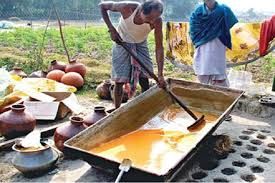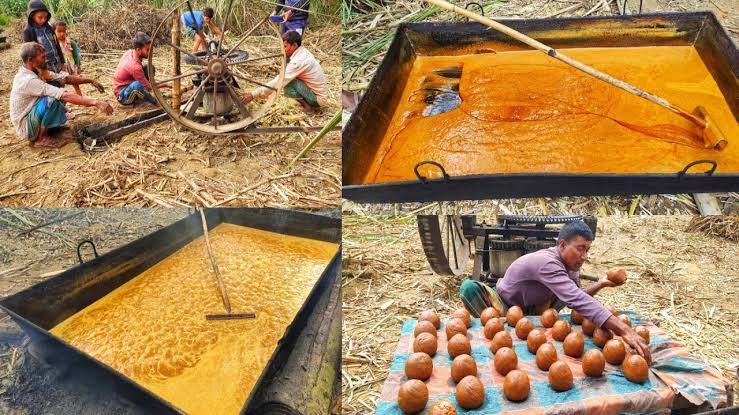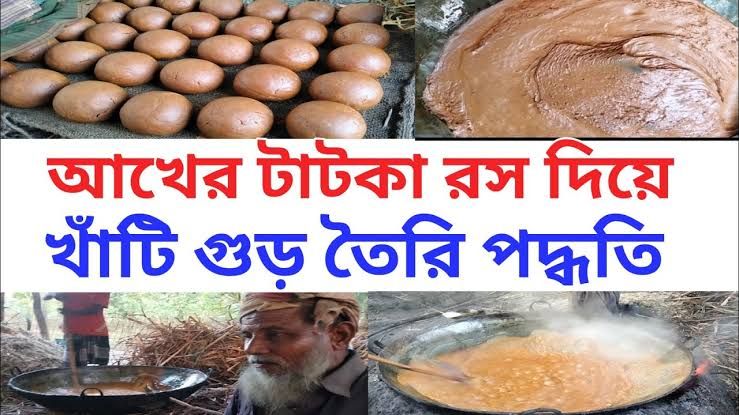
Bismillaher Rahmanir Rahim.
Assalamu Alaikum Wa Rahmatullahi Wa Barakatuhu
Dear Companions Today I want to share with you some words about the evils of killing foetuses.Welcom to this post and congratulations to all
Jaggery, also known as "gur" in South Asia, is a traditional non-centrifugal cane sugar consumed widely across India, Pakistan, Bangladesh, and other parts of the world. Known for its golden-brown color and rich molasses content, jaggery is made from sugarcane juice or, in some regions, from date or palm sap. The process of making jaggery is both an art and science, relying on traditional techniques that preserve its nutrients while creating a natural sweetener. Here’s a comprehensive look at the production, nutritional value, and marketing of jaggery.
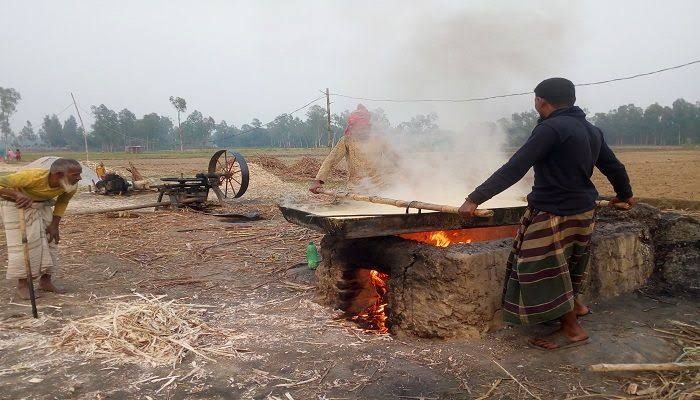
source
The Process of Making Jaggery
The journey of jaggery production begins with sourcing the raw material, typically sugarcane or palm sap.
- Harvesting and Extraction of Juice
The first step involves harvesting mature sugarcane, which is usually done manually. Once harvested, the sugarcane is fed through a mechanical crusher to extract the juice. This juice contains water, sugars (mainly sucrose), and other minor components such as minerals, proteins, and fiber.
In some regions, date palm sap or toddy is collected instead of sugarcane juice. This involves cutting into the stalks of palm trees and collecting the sap that drips out. The method is seasonal, with sap collection taking place during cooler months when the trees yield sap in abundant quantities.
- Filtration and Clarification
The raw sugarcane juice or palm sap is cloudy and contains impurities like dust, bagasse (fibrous residue), and other particles. To purify it, the juice is filtered through a fine mesh or cloth to remove any solid impurities.
After filtration, clarification begins. Traditionally, slaked lime or natural herbs (such as bhindi or ladyfinger extract) are added to the juice. These agents help the impurities rise to the surface, where they can be skimmed off. This step is crucial for ensuring the jaggery produced has a smooth texture and uniform color.
- Boiling and Concentration
Once the juice is clarified, it is transferred to large, shallow iron or copper pans, where it is boiled over a wood or bagasse-fired furnace. Boiling the juice at a controlled temperature evaporates water, concentrating the sugars. This is a labor-intensive step that requires continuous stirring and skimming to prevent burning and achieve the right consistency.

source
As the juice thickens and takes on a caramelized color, it undergoes multiple rounds of skimming to remove frothy impurities. This boiling process takes several hours and is closely monitored to achieve the desired thick, syrupy consistency.
- Cooling and Molding
Once the juice has thickened to a viscous consistency, it is removed from the heat and left to cool slightly. This allows it to become pliable without crystallizing too quickly. Workers then pour the thickened liquid into molds or onto large cooling trays, where it solidifies into blocks of jaggery. These blocks are allowed to cool and harden for a few hours before they are packaged.
- Quality Checks and Packaging
After cooling, the jaggery is examined for quality. Good-quality jaggery is characterized by its golden color, smooth texture, and lack of impurities. Depending on the market requirements, jaggery may be packaged in large blocks, smaller pieces, or granulated form. The product is then wrapped in food-safe materials for distribution.
Nutritional Value of Jaggery
Jaggery is often considered a healthier alternative to refined sugar because it retains several nutrients removed during the refining process. The nutritional composition of jaggery varies slightly depending on the source (sugarcane or palm) and processing methods, but it generally contains:
Carbohydrates: Jaggery is about 65-85% sucrose, providing a quick source of energy. It has a lower glycemic index than refined sugar, meaning it releases energy more slowly.
Minerals: A significant feature of jaggery is its mineral content, including iron, calcium, magnesium, and potassium. This makes it beneficial for individuals needing these essential minerals, such as anemic patients.
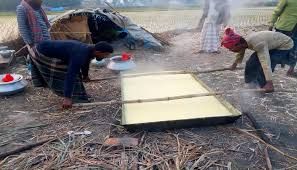
source
Vitamins: Jaggery contains small amounts of B-complex vitamins, such as folate and B6, which support metabolic and neurological health.
Antioxidants: Due to its molasses content, jaggery contains antioxidants, including phenolic compounds. These antioxidants help in combating oxidative stress.
Phytochemicals: Some plant-derived compounds in jaggery have anti-inflammatory properties, making it valuable for managing inflammation.
Health Benefits of Jaggery
The nutritional profile of jaggery provides several health benefits:
Digestive Health: Jaggery is traditionally used as a digestive aid, often consumed after meals to stimulate digestion and prevent constipation.
Detoxification: Jaggery is believed to help cleanse the liver by flushing out toxins. It is also said to clear the respiratory tract, reducing symptoms of asthma and bronchitis.
Anemia Prevention: The iron content in jaggery makes it beneficial for individuals with anemia or low hemoglobin levels. It is often recommended as a natural iron supplement.
Immunity Boost: With antioxidants and minerals, jaggery supports immune health, helping the body fight infections and maintain overall well-being.
Marketing of Jaggery
In today’s health-conscious world, jaggery has gained popularity as a natural sweetener and an alternative to refined sugar. The marketing strategies for jaggery focus on its traditional, natural, and health-promoting qualities.
Positioning as a Health Product
Brands increasingly market jaggery as a health product, emphasizing its natural sweetness and nutritional benefits. This positioning has made jaggery a favorite among consumers who seek organic or unprocessed foods. Health-conscious consumers are drawn to the mineral and antioxidant content in jaggery, perceiving it as a healthier substitute for refined sugar.Organic and Artisanal Labeling
Many jaggery producers use organic labeling, indicating that their jaggery is produced without synthetic fertilizers, pesticides, or additives. Artisanal jaggery, produced using traditional, small-batch methods, is also marketed to appeal to consumers interested in artisanal food products.Diverse Product Offerings
Jaggery is marketed in various forms, including solid blocks, powder, and liquid syrup. Some brands also sell flavored or spiced jaggery products, adding ingredients like ginger or cardamom to enhance its taste and appeal. Granulated jaggery, in particular, is becoming popular because it is easier to use in cooking and baking.E-commerce and Exports
The rise of e-commerce platforms has expanded the reach of jaggery to international markets. Online sales allow consumers worldwide to purchase jaggery directly from producers in South Asia. Exported jaggery is often sold in specialty stores or marketed as part of the health-food sector in Western markets.Packaging Innovation
Innovative packaging solutions have also helped popularize jaggery. Unlike traditional, loosely wrapped jaggery blocks, modern brands offer jaggery in hygienic, resealable packages, which appeal to urban consumers. Smaller packaging options make it easier for consumers to sample jaggery without committing to a large quantity.
Challenges in the Jaggery Industry
Despite its health benefits and popularity, the jaggery industry faces several challenges:
Seasonal Production: Jaggery production is largely seasonal, as sugarcane or palm sap is available in certain months. This limits year-round production and can lead to price fluctuations.
Labor-Intensive Process: The traditional methods of jaggery production are labor-intensive, involving significant manual effort. This makes scaling production difficult.
Quality Control: Ensuring consistent quality and purity is a challenge, as jaggery can sometimes contain impurities. This is particularly an issue for mass-market products.
Competition with Refined Sugar: Although many consumers recognize jaggery’s health benefits, refined sugar is still cheaper and more readily available. Convincing consumers to switch to jaggery can be challenging.
source
The making of jaggery is an intricate process that has been honed over centuries. Known for its unique taste and health benefits, jaggery continues to hold cultural and nutritional significance. Today, the focus on organic and health foods has given jaggery a fresh appeal, and it is marketed as a wholesome, natural alternative to refined sugar. With strategic marketing and product innovations, jaggery is finding a place in kitchens around the world, valued for both its traditional roots and healthful qualities.
